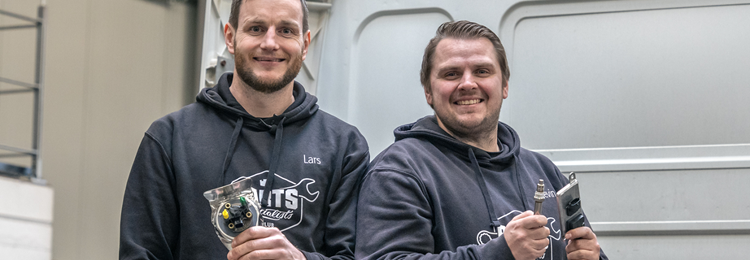
Tips for avoiding errors in everyday workshop life
Date: Wednesday 12 April 2023
In the latest workshop video, the Parts Specialists have to deal with a fault in the exhaust system. Kevin and Lars not only take care of replacing the defective NOx sensor, but also give useful tips on how to avoid faults in everyday workshop life and explain the function of the sensor.
The initial situation is the main inspection, including the exhaust emission test, which is due on the Parts Specialists vehicle. During the emissions test, the values are determined from the control unit by means of a connected tester. As the vehicle’s emissions control light flashes, the workshop professionals carry out a diagnosis, which shows the error “nitrogen oxide sensor”. According to Lars, this indicates that the communication is not in order and that the NOx sensor is therefore affected.
In the first step, the Parts Specialists checks the connector, which does not show any obvious defects such as oxidation. In the next step, Lars checks the PINs of the NOx sensor, which also look flawless. After the cable also shows no chafing or other damage, the duo decides to remove the sensor in order to examine it more closely for possible causes of failure. While Kevin takes care of the sensor, Lars measures the cable with the multimeter. For this purpose, the wiring diagram is needed – unless it is a newer vehicle. In that case, one is partially guided through the test. When measuring, one PIN is connected to the control unit, the other PIN is connected to the cable. This way you can check if the wiring harness is defective and thus causing communication problems. Since the sensor is CAN bus controlled, the two CAN lines must also be measured through.
Lars and Kevin have an important tip regarding the software of the control units. This should always be up to date. In some cases, the sensor must also be replaced at the same time and a different article number installed. Since the sensor and the cables to the control unit are in good condition on the outside, the workshop professionals suspect the fault to be inside the NOx sensor and then turn their attention to a new model.
The function of the NOx sensor is to measure the nitrogen oxides in the exhaust gas stream. The results are analysed and passed on to the control unit. Furthermore, this sensor regulates the AdBlue injection, i.e. the injection of urea into the exhaust gas stream, in order to comply with the EURO5 standard and to avoid environmentally harmful gases. A distinction must be made here between vehicles in which a NOx sensor is installed upstream of the catalytic converter to measure the nitrogen oxides. There are also vehicles with a NOx sensor installed after the catalytic converter. This checks the function of the catalytic converter.
The exact functioning of the NOx sensor is explained in the Parts Specialists video, as are the different variants: https://youtu.be/GmuQm8lF0YQ.
In order to bring their vehicle back into shape, Lars and Kevin install a new NOx sensor and decide on DT Spare Parts article 2.27189. This is followed by the readout of the fault memory and the final exhaust emission test.
To make everyday life easier for other workshop colleagues, the two have practical tips on troubleshooting at the ready. The biggest problems usually lie in outdated software or in the article selection itself, which is not vehicle-specific. In the latter case, the chassis number is helpful. In addition, scorched cables indicate thermal overload. Sufficient cable ties for correct cable routing can help here. A bluish discolouration of the sensor head also indicates thermal overload. Possible causes include problems with combustion or in the exhaust gas flow. AdBlue deposits, on the other hand, often have their origin in a defective metering unit or non-functioning control system. Oil residues on the sensor can possibly be traced back to a defective turbocharger. Further hints and tips with regard to the NOx sensor can be found in the workshop video and on the Parts Specialists YouTube channel: ps-web.tv.
For exhaust gas aftertreatment, the DT Spare Parts range includes numerous components, such as the AdBlue system, including the AdBlue feed pump with the matching AdBlue filter and different dosing modules. In addition, customers will find various exhaust gas temperature sensors, exhaust pipes and catalytic converters in the range. All articles can be found in the Diesel Technic Partner Portal: partnerportal.dieseltechnic.com.
For technical questions, the Parts Specialists can be contacted at any time via their HelpDesk: helpdesk.dieseltechnic.com.
